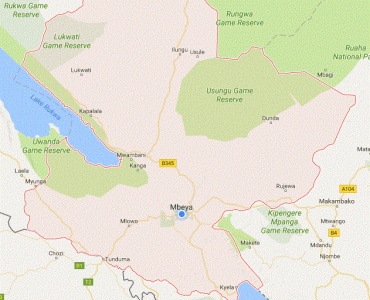Mbeya region has a total surface area of 35,954sq. kms out of which 461.7 sq.kms is covered by water bodies of Lake Nyasa and several rivers while the remaining 34,144.3 sq.km is land area. Administratively, the Region is divided into 5 districts with 7 Local Government Authorities (LGAs).
The Administrative Districts include Mbeya, Chunya, Mbarali, Kyela, Rungwe, 15 divisions, 178 wards, 533 villages and 181 Mitaa. According to the 2012 census the undivided Mbeya region had a population of 2,707,410 people out of whom 1,297,738 are male and 1,409,672 are female. The new Mbeya Region population projection of 2016 was 1,883,024, out of whom 902,479 are male and 980,545 are female.
Mbeya has a good road transport connection to Dar es Salaam (the main harbour and commercial city of Tanzania) and to other neighbouring regions. There is also a railway line which links Mbeya to Dar es Salaam and Kapirimposhi in Zambia. The existence of Mbeya – Malawi Cargo Dry port is an added 8 advantage. All key economic areas within the region can be reached with ease. There is a new international airport Songwe as started operating linking Mbeya with Dar es Salaam and link to other cities of Southern African countries such as Malawi, Zambia, Democratic Republic of Congo, Mozambique, and South Africa. Water supply system is also adequately developed for domestic and industrial use.
The region is also connected to the National electricity grid system which is continually being upgraded and expanded to meet the present and future requirements. There is a good number of modern communication and media companies operating in the region, serving both local and international needs. Topographically, Mbeya Region consists of 3 ecological zones: lowlands (within the Rift valley), plains (including Usangu wetlands) and highlands (Uporoto highlands and Livingstone mountain ranges). These ecological zones are favourable for the development of agriculture, forestry, industry, tourist services and mining.
Apart from rain fed agriculture, the Region has about 110,721 hectares that are suitable for irrigation, out of which 25,626 hectares need to be developed. The Region is also rich in a variety of mineral deposits including coal, gold and industrial minerals such as limestone, marble, iron ore and phosphates. Mbeya Region has a large tourist potential with famous sites such as Lake Ngosi, Ihefu wetland plains, Matema Beach, etc. 9 The economy of Mbeya is based on agriculture, livestock and bee keeping, fishing, commerce and manufacturing. Other economic activities and potentials include mining and tourism. On the basis of current prices, Mbeya Regional Gross Domestic Product was Tshs 5.831 trillion and per capital income was Tshs. 3,097,049 in year 2016. The Region contributed 5.62 % in the national income (GDP) holding a third position national-wide after Dar-es-Salaam and Mwanza
To maintain and improve this growth target, the Region has planned to concentrate on the following activities: First, further development of agriculture, livestock farming, forestry, fisheries and beekeeping sub-sectors for large volume and high quality production to meet domestic and export markets. Second, expansion of important road networks to key economic areas including industrial zones in urban areas. Third, taking measures aimed at expanding and developing the tourist sector.
The fourth step is to gradually transform and update utilities infrastructure including electricity, water supply and sewerage systems. Apart from our own efforts, the region wishes to attract investments from domestic and foreign investors as well as economic organizations for the purpose of exploiting the regions opportunities on the basis of mutual benefits in various areas. Therefore, I am looking forward to cooperate with you in making Mbeya Region a vibrant investment location in Tanzania
Welcome to Mbeya Region! Karibuni Mkoani Mbeya!

2 Barabara ya Kamishina, 53180 MBEYA
Anuani ya Posta: P. O.Box 754,Mbeya.
Simu: 025-2504045
Simu ya Mkononi:
Barua pepe: ras@mbeya.go.tz
Haki Miliki©2023 Mkoa wa Mbeya. Haki zote Zimehifadhiwa